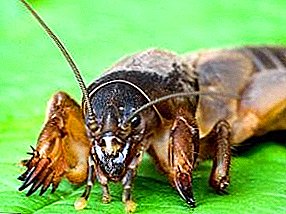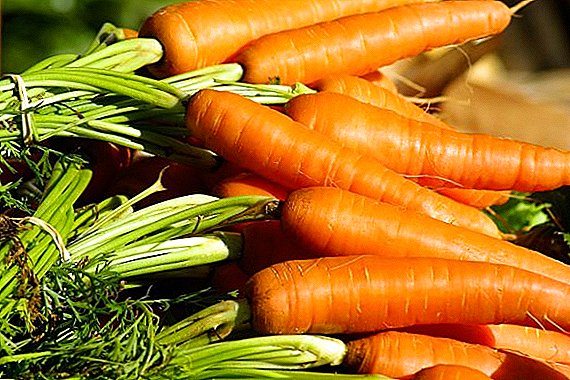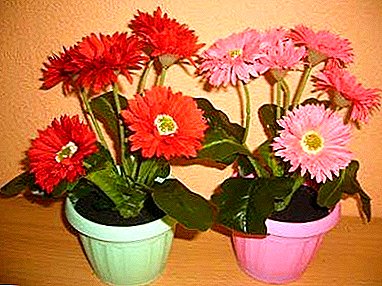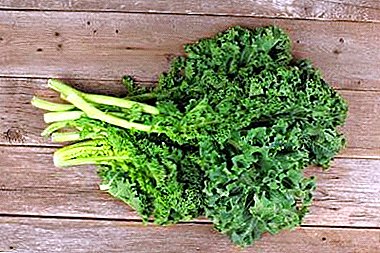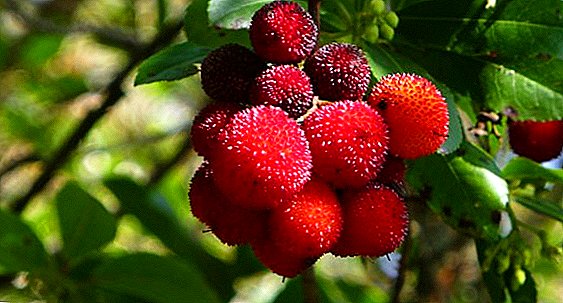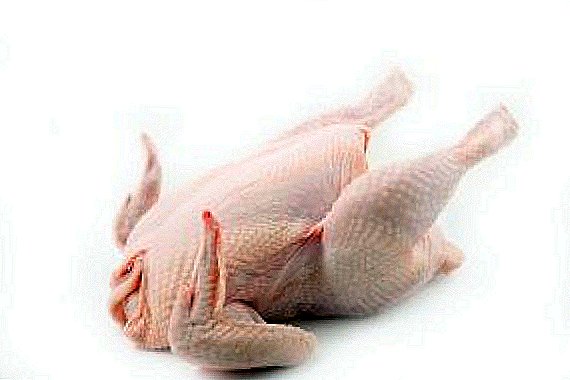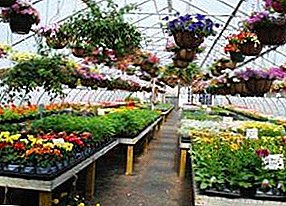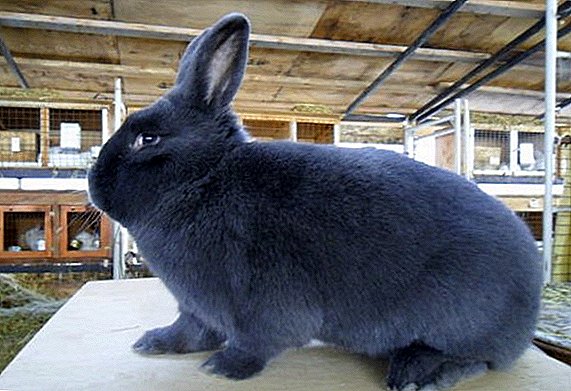 Today, there are about 200 rabbit breeds in the world. Each of them has its own characteristics, but the combined meat and skin is the most valuable breed - the Viennese blue rabbit. In our article we describe this animal, as well as describe how to maintain and breed it at home.
Today, there are about 200 rabbit breeds in the world. Each of them has its own characteristics, but the combined meat and skin is the most valuable breed - the Viennese blue rabbit. In our article we describe this animal, as well as describe how to maintain and breed it at home.
Breed description
To have an idea about this breed, we suggest to get acquainted with the history of its occurrence and the description of rabbits.
Inference history
The Vienna Blue Rabbit was bred in 1895 in Vienna as a result of the reproductive crossing of a blue Moravian rabbit with a Flandre rabbit. The best representatives of the new breed were exported to Switzerland, Germany and Holland in 1903.
Check out the best rabbit meat breeds.
Scientists sought to gradually increase the weight of the animal, the size of its skins, wanted to improve the quality of fur and increase fitness. As a result of their work, the weight of animals was already 4-4.5 kg, and some individuals reached a mass of 7 kg. 
External differences
Representatives of the breed have a dense, slightly elongated body about 57 cm in length. The size of the ears is about 13-15 cm, they are slightly rounded at the tips, the eyes have a dark blue color. An adult rabbit weighs on average 4.5-5 kg, but some animals can reach 6-7 kg.
Wool of the Vienna rabbit has a steel color with a bluish tinge. The head is small, light.
Direction and character
Viennese rabbits are highly valued as an ornamental and meat-skin type. They are engaged in breeding in order to get dietary meat and valuable fur. The skins are quite large, soft, very fluffy. Of them make interior products and clothing.
Read about the features of breeding rabbits white giant, Californian, marder, ram.
The main qualities of Ushastikov are friendliness, playfulness and curiosity. Everything is interesting for them, they will be happy to explore new territory. Quite often, these animals are offended. Being rude to rabbits is unacceptable, because when they hear sharp cries or feel indifferent attitude, they often withdraw into themselves, begin to show aggression and become frightened.
Being rude to rabbits is unacceptable, because when they hear sharp cries or feel indifferent attitude, they often withdraw into themselves, begin to show aggression and become frightened.
Important! Be sure to put straw or hay in a cage with rabbits: if this is not done, they will begin to gnaw the bars of the cage.
Advantages and disadvantages
The main advantages of the breed include:
- high fertility rates;
- the presence of a beautiful and unique wool cover;
- ability to adapt to harsh conditions;
- high rates of hides and meat.
- strong exposure to stress;
- aggressive behavior as a result of a negative attitude on the part of a person.
How to choose healthy rabbits when buying
Breed standards say that it is necessary to acquire a rabbit at a mature age, and its weight should be 4-5 kg. The skin should have a uniform color, it is not allowed the presence of white or brownish spots.
The skin should have a uniform color, it is not allowed the presence of white or brownish spots.
Did you know? Not only the wool, but also the claws of the Viennese rabbit are colored gray-blue.It is recommended to acquire animals either in specialized nurseries, or from proven breeders who have been breeding for years already.
When buying, you should carefully examine the animal. It must be mobile, gallop. Fluffy should have smooth paws and tail sticking up. The shape of the back is rounded, without a hump. If the back is failed - this is an unhealthy symptom.
Tilting the head or turning it to one side indicates that cerebral circulation is impaired in a rabbit, and it is better to look for another individual to buy it.
Be sure to pay attention to the teeth and bite. It is necessary to close the teeth of the animal, and if the bite is correct, the upper teeth will be found on the lower ones.  After the inspection is completed, it is necessary to talk with the seller about the health of the animal, the vaccinations given to him, about the state of health of the parents of fluffy, and also do not forget to ask about eating habits.
After the inspection is completed, it is necessary to talk with the seller about the health of the animal, the vaccinations given to him, about the state of health of the parents of fluffy, and also do not forget to ask about eating habits.
Conditions of detention
The breed is quite unpretentious, so its representatives will feel great in the equipped rabbitry, barn or other outbuildings. The best option is to keep it in individual cells, since it will be easier to control the health and diet of the fluffies.
Important! Every day for 1.5 hours it is necessary to let the rabbit out of the cage for a walk, otherwise it can get bored and get sick.When equipping the rabbitry, the following rules should be observed:
- it is worth placing the cage in such a way that direct sunlight does not fall on animals;
- the bottom of the cage should be covered with wood or plywood, and a layer of hay should be put on top, which should be changed periodically;
- It is important to monitor the humidity of the air in the cell - it should be at the level of 60-75%;
- temperatures above +30 ° C, as well as severe frosts, adversely affect animals and can be fatal;
- in winter, when daylight hours are short, it is important to take care of artificial light in the rabbitry;
- it is necessary to ensure that there are no drafts in the room, as well as to eliminate sudden drops in night and daytime temperatures.

How to care
Rabbits love cleanliness, so it is very important that the cage is always clean. Cleaning should be carried out at least once every 7 days, and it is also worth periodically disinfecting all inventory.
Did you know? Rabbits have an unusual eye structure: even without turning their heads, they can see what is happening behind them.Make sure that there is always fresh water in the drinker. In order for the fluffies to not overturn the bowl, it should be attached to the wall. Cleaning the feeders should be done every day, as there may be food in it, souring or spoilage of which can cause various diseases.
Every 2-3 days, a complete replacement of the litter should be mandatory. This is necessary so that the cage will always be dry.
An important role in keeping the rabbits is vaccination. Vaccinations against diseases such as myxomatosis and viral hemorrhagic disease (ARVD) are mandatory.  The first vaccination for myxomatosis is carried out in the spring, when the animal is at least 4 weeks old. The second dose is given 4 weeks after the first, and the third 5-6 months after the initial vaccination. If all three stages were carried out successfully, then it is necessary to do the vaccination twice a year - in the beginning of spring and the beginning of autumn.
The first vaccination for myxomatosis is carried out in the spring, when the animal is at least 4 weeks old. The second dose is given 4 weeks after the first, and the third 5-6 months after the initial vaccination. If all three stages were carried out successfully, then it is necessary to do the vaccination twice a year - in the beginning of spring and the beginning of autumn.
Important! Only a completely healthy animal can be vaccinated. If the rabbit was sick, you can get an injection 2 weeks after recovery.
The first vaccine for VGBK is carried out when the animal is 6 weeks old and its weight is 500 g. The second vaccination is given after 3 weeks. Then you should repeat the vaccination every 6 months.
In addition to the main vaccinations, you can vaccinate against:
- pasteurellosis;
- salmonellosis;
- rabies;
- listeriosis.
Rabbits are prone to many diseases, so you should know what diseases exist in rabbits and how to treat them.
What to feed
In order to breed rabbits with the aim of obtaining meat and skins to be effective, due attention should be paid to their diet. Despite the fact that the breed is unpretentious in the diet, you should try to diversify the menu. The diet should contain such food:
The diet should contain such food:
- rude;
- juicy;
- green;
- concentrated.
- lupine;
- oats;
- winter rye;
- clover;
- alfalfa;
- peas
Find out which grass can and should not be given to rabbits.
Juicy feeds include silage, garden fruits, root vegetables (potatoes, carrots, beets) and melons (pumpkin, zucchini, watermelons). They have a lot of useful elements that are necessary for rabbits.  Useful grass for rabbits Thanks to coarse feed, the animal's body gets fiber, minerals and vitamins. These include:
Useful grass for rabbits Thanks to coarse feed, the animal's body gets fiber, minerals and vitamins. These include:
- straw;
- hay;
- branch feed - maple, acacia, linden, willow, willow.
Feeders should be positioned in such a way that the fluffies can freely eat at any time.
We recommend to learn how to make a feeding trough and a drinking bowl for rabbits with your own hands.
You should not give pets high-calorie foods too often, for example, boiled potatoes or high-fiber foods. This can lead to obesity, which, in turn, will adversely affect the quality of meat. In addition, intestinal swelling may appear, which will significantly weaken the rabbit's health.
Rearing
Puberty in the rabbit comes at the age of 5-6 months, in the male - at 6-7. Healthy animals should be involved in mating, which have high productive indices, expressed pedigree qualities, which gained at least 80% of the body weight of adult rabbits.  If the goal is not breeding, but pure breeding, representatives of the same breed should participate in mating, with no family ties between them. Usually one rabbit fertilizes up to 8 rabbits.
If the goal is not breeding, but pure breeding, representatives of the same breed should participate in mating, with no family ties between them. Usually one rabbit fertilizes up to 8 rabbits.
Did you know? The rate of chewing in rabbits is 120 times per minute. At the same time they have 17 thousand taste buds.
The gestation period for females is 28-32 days. In most cases, okrol occurs at night or in the morning. The procedure takes place without any particular difficulties, lasts 10-60 minutes. Situations when a person needs to intervene usually do not arise, because the rabbit rarely eat their babies. They almost always have milk, so the bunnies have a rather responsible attitude towards feeding the young.  It is important to sanitize the room for the female before the bathing season, to place there many drinking bowls, since after the birth of the babies the female will experience a strong thirst. There should be a clean, soft bed on the floor so that the little ones feel warm and comfortable. The restoration of the rabbit after a roundtrip occurs very quickly - after 24 hours, she can participate in the next pairing.
It is important to sanitize the room for the female before the bathing season, to place there many drinking bowls, since after the birth of the babies the female will experience a strong thirst. There should be a clean, soft bed on the floor so that the little ones feel warm and comfortable. The restoration of the rabbit after a roundtrip occurs very quickly - after 24 hours, she can participate in the next pairing.
The Viennese blue rabbit will not only beautify your yard, but will also give you the opportunity to earn good money. All that is needed for this is appropriate pet care and a complete diet.
Video: Vienna Blue Rabbit
Reviews

to get the skin should be kept for a long time (so that it shed and the size was not 3-4 months)
Vienna held a little over 2 years was at two exhibitions.
Ask why the exhibition? This is to know everything about this breed and its features.
and know who is who. Currently there are 3 lines, i.e. 3 independent manufacturers
and under them girls.




